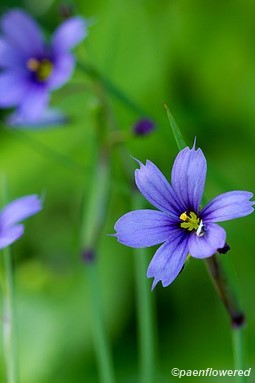Sisyrinchium angustifolium
Sisyrinchium angustifolium narrow-leaved blue-eyed-grass
There are at least nine native species in this area known as blue-eyed-grass, all members of the iris family. They are not really a type of grass. They were formerly classified as a member of the lily family. The various species can often be difficult to differentiate. This is one of those species that has branched stems, though the plant is often so tall and slim it is difficult to show the stem and flowers in one view. It is most similar to the less common Eastern blue-eyed grass (S. atlanticum), but that species has even more narrow, but shorter leaves.
This is a perennial plant and is found in meadows, flood plain forests, open woodlands, and along shores. It is more of a woodland plant than the related species. It is found throughout eastern North America and blooms from May through July. Narrow-leaf blue-eyed-grass is found in every county in Pennsylvania.
The small (1/2 inch) blue or violet blue flowers have six tepals (3 petals and 3 sepals that are identical in appearance), each with pointed tips. The central stamens and pistil are yellow. The color darkens a bit towards the center of the flower and there are darker lines along the petals that serve as nectar guides for insects. The flower has no scent. The flowers form in clusters but usually only a few are in bloom at any one time. In this area the normal blooming period is June and July.
The leaves are about a ¼ inch wide and the stems a bit narrower. The plant grows from and can spread from an underground rhizome. The flower stalk is flat and often twisted. The plant grows 6 to 20 inches high, but can be shorter if in a mowed lawn or poor soil conditions. This blue-eyed-grass has been cultivated as an ornamental. It is also called the stout blue-eyed-grass.
Habitat & Range
Common in damp soil and meadows, fields, & open woods.
Present throughout the state.
| EMP: | FACW |
|---|---|
| NCNE: | FAC |
Phenology
Flowers May to July.
Plant Codes
S-rank: No rank
G-rank: G5 (Secure)






Comments
Have you spotted this plant in your area? We'd love to hear about your experience! Share your comments or questions about the plant below. Comments are moderated before posting.